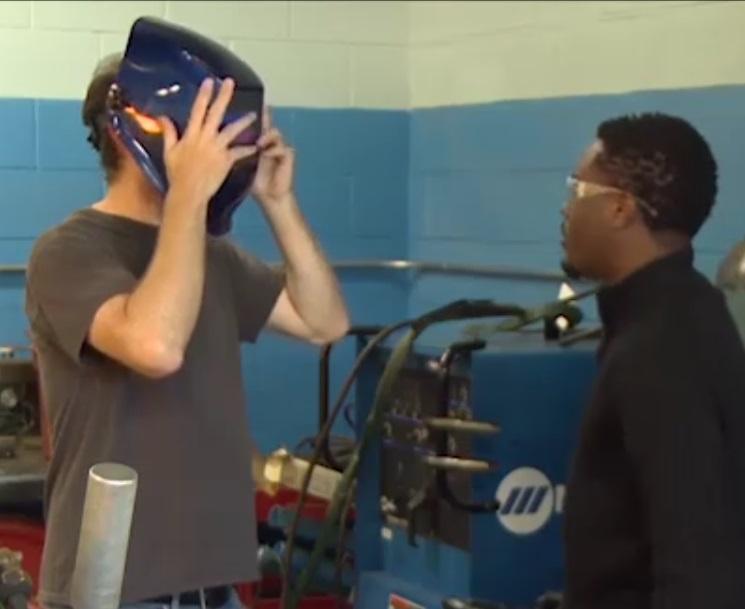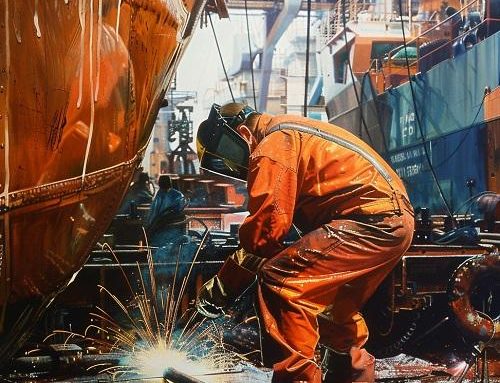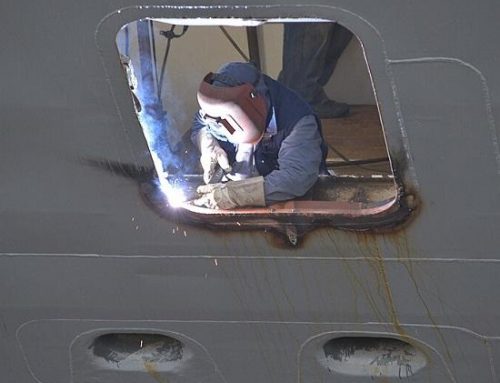Introduction
Welding is an indispensable industrial process across many sectors like construction, manufacturing, energy, and more. However, it also poses serious occupational hazards that must be addressed through proper safety protocols. This comprehensive guide examines the range of hazards involved in welding and cutting activities, the mechanisms behind them, and actionable steps welders can take to protect themselves. By understanding the risks and following key precautionary measures, welders can practice their vital trade more safely.
The Extreme Heat Hazard
A primary hazard posed by welding is the tremendous amount of heat involved in most applications. For example, oxy-fuel cutting reaches over 6,000°F and arc welding exceeds 10,000°F (1). These extreme temperatures are achieved by burning fuel gases like acetylene or through high-voltage electricity. The heat is more than enough to cause severe burns by direct contact with the welding apparatus itself or heated metals being worked on. Proper protective clothing is essential, including leather gloves, fire-resistant jackets and pants, and high-topped boots to shield the skin. Leather sleeves and leggings add further protection against incidental contact and sparks. Welders should take care to not accidentally touch hot surfaces even with gloves on, and use tools to handle heated metals.
The Dangers of Ultraviolet and Infrared Radiation
In addition to high temps, welding and cutting release substantial ultraviolet (UV) and infrared radiation. Exposure to this intense radiant energy can cause ‘arc eye’ or ‘flash burns’ on unprotected eyes and skin (2). Symptoms range from eye pain and irritation to corneal swelling that can temporarily impair vision. With repeated exposure, permanent eye damage and even blindness can occur. UV radiation also contributes to accelerated skin aging and skin cancer risk. Proper eye and face protection is vital through the use of helmets, handheld shields, and goggles fitted with the right filters and lens opacity to block the emitted radiation. Nearby workers should also be protected with screens/curtains and their own eye protection.
The Risk of Electric Shock
Electric arc welding in particular carries the hazard of severe or fatal electric shock. Welders are exposed to high voltage electricity up to thousands of volts. Faulty wiring, damaged cables, wet conditions, and physical contact with the electrode can all lead to dangerous shocks. Strict control of electrical hazards is required, including insulation, grounding, guarding live parts, and use of dry insulating materials (3). Welders should inspect cables and connections and avoid wrapping cables around their bodies. Insulated gloves specially rated for electrical work provide an added layer of protection. Proper training in electrical safety is fundamental.
Fume Hazards and Respiratory Protection
Heated metals and coatings release clouds of potentially toxic fumes during welding that can be inhaled. Contaminants like lead, cadmium, nickel, chromium, manganese, and others can cause acute effects ranging from dizziness to ‘metal fume fever’ (4). Chronic exposures may lead to lung cancer, neurological or kidney damage, and other lasting health effects. Mechanical ventilation through local exhaust or dilution ventilation is the primary method for controlling concentrations of airborne contaminants in the welder’s breathing zone (5). Where ventilation alone cannot sufficiently reduce fumes, welders must wear proper respiratory protection matched to the composition of fumes being generated.
Fire and Explosion Hazards
The open flames and heat involved in welding present serious fire and explosion risks due to ignition of flammable materials. Fuel gases used in gas welding are also flammable. Sparks can fly long distances from the welding arc and molten slag can escape the work area. Nearby flammable chemicals, wood, paper, textiles, and even dust buildup or litter on floors can be ignition sources. Companies must establish ‘hot work’ procedures to identify hazards like these and make sure the area is fire-proofed before work begins, such as by relocating or protecting combustibles (6). A permit system verifies that precautions have been taken. A fire watch monitors the area during and after welding to catch stray sparks. ABC fire extinguishers must be kept handy by the welder.
Confined Space Considerations
Welding in confined spaces like tanks and manholes poses additional, life-threatening hazards. Toxic fumes can rapidly accumulate in the restricted air volume. Ignition risks are amplified as well. Before entry, the space must be evaluated for oxygen level, flammable/toxic air contaminants, and the potential for engulfment. Adequate ventilation is key. Monitoring of the atmosphere is required while working inside. Emergency plans and trained standby personnel are essential (7). All other standard confined space protocols must be strictly followed. Welding should be avoided in confined spaces if possible by moving the work outside.
The Dangers of Pressurized Fuel Gases
Some welding methods like gas welding rely on flammable gases like acetylene as a fuel source. These gases are stored in heavy, highly pressurized cylinders and can explode if damaged, heated, or improperly handled. Sudden release of these compressed gases can turn them into dangerous projectiles. Valves, regulators, hoses, and cylinders must be maintained in good condition. Cylinders should be chained upright to a wall or cart to prevent tipping and be transported on a wheeled cart with a safety cap installed. They should be kept away from heat sources and oxidizers. Proper training in handling compressed gas cylinders is essential.
Designated Welding Areas
To isolate welding hazards, companies establish designated welding areas that are restricted to only welding work. These spaces have all flammable materials removed and fire-resistant construction. Welders can work safely in these areas without additional precautions. Where possible, companies should perform welding tasks in the designated areas rather than throughout the facility.
Permit Systems for Non-Authorized Locations
When welding must occur outside of the authorized welding area, such as during plant maintenance, a ‘hot work permit’ system helps ensure safety. A supervisor inspects the location, identifies risks like nearby flammable liquids or presence of combustible dust, and implements protections like relocating materials or setting up screens. The supervisor then fills out a permit listing the precautions taken. The welder reviews the permit before starting work and follows its requirements. Permits ensure the location is truly ready for hot work.
Hearing Protection
In addition to heat and light exposure, welding generates hazardous noise levels from the work itself coupled with nearby equipment like grinders or compressors. Prolonged noise exposure can lead to permanent hearing loss. Welders should wear ear plugs or muffs with adequate noise reduction ratings. Ear protection prevents hot slag from entering the ear canal as well.
Conclusion
By understanding the array of hazards associated with welding and cutting work, welders can take proactive steps to protect themselves through proper protocols, equipment, training, and vigilance. While welding requires taking calculated risks, being aware and being safe allows welders to avoid injuries and illnesses from this vital industrial work.
Sources:
- CDC – Welding – NIOSH Workplace Safety and Health Topic https://www.cdc.gov/niosh/topics/welding/default.html
- Eye Protection against Radiant Energy during Welding and Cutting. – PubMed – NCBI https://www.ncbi.nlm.nih.gov/pubmed/15672955
- OSHA Quick Card – Protect Yourself from Welding Fumes and Gases https://www.osha.gov/Publications/OSHA_FS-3644_Welding.pdf
- Welding Fumes: Preventing Potential Health Problems : OSH Answers https://www.ccohs.ca/oshanswers/safety_haz/welding/fumes.html
- Ventilation for Welding and Cutting – Quick Card TM (osha.gov) https://www.osha.gov/sites/default/files/publications/OSHA_FS-3697_Welding_Ventilation_Poster.pdf
- 1915.504 – Fire prevention. | Occupational Safety and Health Administration https://www.osha.gov/laws-regs/regulations/standardnumber/1915/1915.504
- Confined Spaces in Construction – Welding Hazards : OSH Answers https://www.ccohs.ca/oshanswers/hsprograms/confinedspace_welding.html
As we’ve explored the complex landscape of welding hazards and the critical need for safety measures, it becomes clear that education and proper training are paramount. The dire statistics, including fifty fatalities and thousands of injuries a year, underscore the urgent need for comprehensive safety programs. With that in mind, we present an opportunity to address these challenges and create a safer welding environment through specialized training products tailored to the needs of those working in this vital industry.
Our “Welding Safety” training products are designed to change these alarming statistics. These comprehensive materials cover all aspects of safety, from the potential hazards of welding to protective equipment. Offered in both English and Spanish, the courses include:
- The Potential Hazards of Welding
- “Designated Areas,” Work Permits, and Confined Spaces
- Fire Prevention While Working
- Protecting Against Toxic Fumes
- Goggles, Helmets, and Hand Shields
- Gloves, Clothing, and Other Protection
All our products, including new “Micro-Learning” and full-length online courses, DVDs, and interactive CD courses, are integral to employees’ understanding of welding safety. With our Welding Safety Detailed Course Outline, SCORM 1.2 compliance, and dedicated support from Nevada Technical Associates, we ensure that safety comes first in your workplace.










